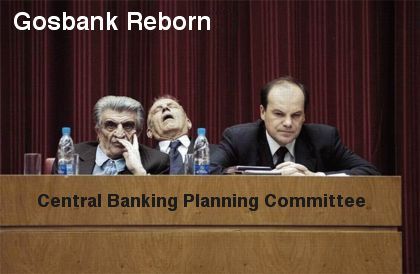 |
Today the GSEs Fannie Mae and Freddie Mac merged with the Federal Reserve Bank, the US Treasury Department, Goldman Sachs, Citigroup and JP Morgan Chase to form Gosbank USA. The DJIA rose 280 points on the news.
Capping a year of crisis in the credit markets and global financial system that led to the nationalization of banks in Europe and England, the US today consolidated and merged ownership of the nation’s largest banks under co-chairmen former Federal Reserve Chairman Ben Bernanke and former Treasury Secretary and ex-head of investment banking giant Goldman Sachs Henry Paulson. “We made lemons out of lemon-aid and turned a terrible crisis for the US economy and the American people into a golden opportunity to expand the power and reach of the State,” said Paulson in a speech made today from the new headquarters of Gosbank USA on Wall Street, the new administrative center for several recently created US government planning authorities, including Gosfin USA, the State Central Financial Regulatory Authority, and Gosrec USA, the State Central Housing Reconstruction Authority.
The new bank gets its name from the Soviet era Gosbank.
Gosbank (Gosudarstvenny bank SSSR—the USSR State Bank) was the central bank of the Soviet Union and the only bank whatsoever in the entire Union from the 1930s until the year 1987. Gosbank was one of the three Soviet economic authorities, the other two being "Gosplan" (the State Planning Committee) and "Gossnab," the State Committee for Material Technical Supply.
The Soviet state used Gosbank primarily as a tool to impose centralized control upon industry in general, using bank balances and transaction histories to monitor the activity of individual concerns and their compliance with Plans and directives. Gosbank did not act as a commercial bank in regard to the profit motive. It acted, theoretically, as an instrument of government policy. Instead of independently and impartially assessing the creditworthiness of the borrower, Gosbank provided loan funds to favored individuals, groups and industries as directed by the central government. - WikiPedia: Gosbank
One of the first initiatives for the new bank is to restructure loans made to borrowers during the housing bubble to extend the payment periods from 30 to 100 years under a new federal government loan program called "Debt for Life."The Soviet state used Gosbank primarily as a tool to impose centralized control upon industry in general, using bank balances and transaction histories to monitor the activity of individual concerns and their compliance with Plans and directives. Gosbank did not act as a commercial bank in regard to the profit motive. It acted, theoretically, as an instrument of government policy. Instead of independently and impartially assessing the creditworthiness of the borrower, Gosbank provided loan funds to favored individuals, groups and industries as directed by the central government. - WikiPedia: Gosbank
“We’re reading your email, you work for a company that manufactures weapons or other goods for the government or you will soon enough, and now we’re managing your investments and loaning you the money you need to eat and put a roof over your head. You work in our companies and you live in our houses. It just doesn’t get any better than this,” remarked Paulson.
President Bush applauded the formation of the new bank as key to restoring confidence in financial markets.
(Hat tip to iTuliper krakknisse for the pointer to Gosbank.)
AntiSpin: Actually, this is a reprint of our April Fool's posting this year: Massive new Gosbank USA formed, market soars. Hey, what can we say? We had a "feeling" this was going to happen. If you think we're kidding about the rest of it, read it again.
Comment